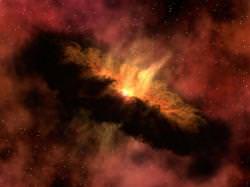Ever wonder how the Earth got its oceans? Well, new data gathered by NASA’s Spitzer Space Telescope could provide a clue. The telescope imaged a planetary disk forming around a young star, surrounded by a cloud of water vapour. This water is raining down right into the dusty disk where planets are thought to form.
Now that’s convenient.
The discovery appears in the August 30th edition of the journal Nature. According to the discovering astronomers, there’s enough water vapour located in the star system NGC 1333-IRAS 4B, located about 1,000 light-years away, to fill up the oceans on Earth 5 times over.
Astronomers used to believe that Earth’s water arrived early on in our Solar System’s formation in the form of icy comets. The early Earth was bombarded by comets large and small, and our oceans slowly built up over time. But this research indicates that water falling as ice will actually vapourize as it arrives from the stellar envelope to its disk.
The discovering team studied a total of 30 stellar embryos, using Spitzer’s infrared spectrograph, which can peer through obscuring dust. Of all the systems they analyzed, only one had such a strong signature of water. The vapour was easy to spot for Spitzer because when the ice falling from the envelope into the planet-forming disk, it heats up, glowing with infrared light.
Is this a rare situation? The astronomers believe the water signature was so bright because the star system is perfectly lined up for Spitzer to be able to see its bright core. It’s also probably that this phase of planetary formation is very short lived, so the other systems have already gone through this phase, or will do so shortly.
Original Source: NASA/JPL/Spitzer News Release

